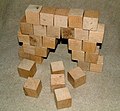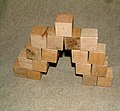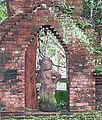Cantilever arch

In architecture, a cantilever arch ( English corbel arch ) or false arch is a construction method for bridging door or window openings in the masonry . It is considered to be a historical preliminary stage of the real bow . It can be with sufficient steepness of the side surfaces easily and without falsework brick construction. A cantilever arch can be viewed as a series of fighters or consoles lying one above the other .
It can be found in old buildings, such as the Mayan archways , and when old masonry collapses with the loss of stones. It is no longer used in modern buildings.
The distinction between real and fake bow
With a real arch (round arch) the arch stones are arranged radially. In the case of the wrong arch (cantilever arch) , the arch stones are arranged overlapping (= cantilever).
In a real arch, the keystone is clamped under tension by the remaining arch stones . This is not the case with the idealized special form of the false arch (top left). In the case of a wider and irregularly bricked false arch, as in the illustration above, there will also be a constraint between the stones of the arch.
construction
Stone lintels are complex to manufacture and not very resilient. Due to minor subsidence in the structure, cracks often form over time. Wooden lintels are only suitable for certain spans. They are sensitive to fire and moisture and were often not provided in monumental stone buildings for aesthetic reasons.
Instead of a girder , ancient cultures therefore often used cantilever arch construction with hardly any tensile forces. Successive cantilevers make the opening smaller towards the top until it can be closed by one or two closing stones with a small span.
If sufficiently long stones are used or the arch is built steeply enough, cantilever arches, in contrast to real arches, do not depend on supporting scaffolding during the construction phase. This does not apply to filigree cantilever arches, which are also dependent on the load of the surrounding masonry for final stabilization.
The series of pictures above shows a wall (picture 1) from which three stones are being removed. The wall does not collapse, but three more stones fall out, forming an opening in the shape of a triangle (Fig. 2): A cantilever arch has formed in the wall. Its load-bearing capacity is low, it is stabilized by the weight of the surrounding stones. The structure can hardly be made leaner without collapsing (Fig. 3, the cantilever arch is about to collapse).
While ideally only compressive forces occur in a real arch, the building material of a cantilever arch must also absorb shear and more or less large tensile forces . They are technically easier to build.
Due to the less clear distribution of forces, particularly wide cantilever arches and those made with little or weakly binding mortar cannot be made as filigree as real arches.

A cantilever arch is created unintentionally when stones fall out of damaged masonry; the stones remaining above then hold each other through compressive forces and form a false arch, as long as there is sufficient contact between the stones and the pressure is secured by load.
The originally existing wooden lintel has broken out of the wall in the picture opposite , along with parts of the masonry.
Examples

The Maya in Mesoamerica as well as the Egyptian and Indian and behind Indian cultures knew no genuine bow. The picture on the right is typical for the construction of gate openings. The smoothed walls of the arched reveal run upwards at an acute angle and end in a flat stone slab.
Cantilever arches can also be found as structural elements in prehistoric stone buildings, for example in the Minoan culture in Crete or among the Nuragi in Sardinia around 1500 BC. Chr., See picture on the left.
gallery
Cantilever arch in a prehistoric stone castle
Cantilever arch of the Mycenaean " Treasury of Atreus "
Cantilever arch of the entrance to the royal palace of Ugarit
Arch of Kabah (around 800)
Labná Arch (around 800)
Cantilever arches of the portals of the Quwwat-ul-Islam Mosque in Delhi (around 1195)
A corbelled vault over the colonnade of the Palace of Palenque
Brick cantilever arch in Ubud in Bali , Indonesia
Brick cantilever arch in My Son in Vietnam
Stone cantilever arch in the Sun Temple of Konark , India













